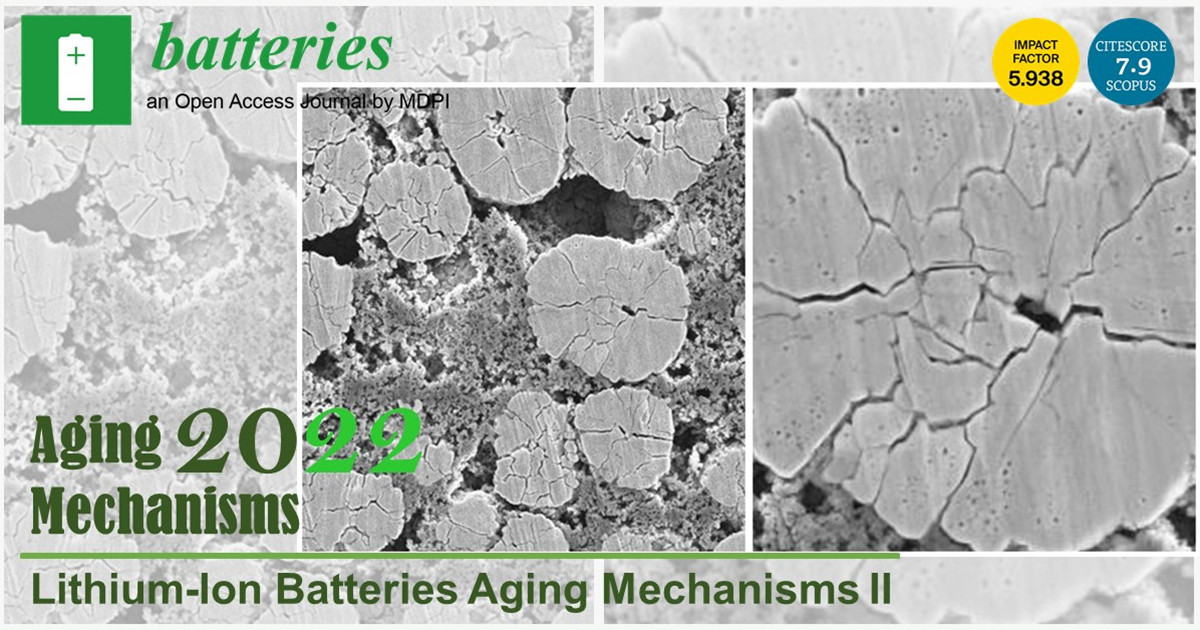Lithium-Ion Batteries Aging Mechanisms, 2nd Edition
A special issue of Batteries (ISSN 2313-0105). This special issue belongs to the section "Battery Performance, Ageing, Reliability and Safety".
Deadline for manuscript submissions: closed (12 January 2023) | Viewed by 57846

Special Issue Editor
Interests: Li-ion batteries; nanomaterials; density functional theory; molecular dynamics; electrochemistry
Special Issues, Collections and Topics in MDPI journals
Special Issue Information
Dear Colleagues,
Lithium batteries (including lithium-ion, lithium–sulfur and lithium–air cells) are considered enabling technology for important industrial sectors including electrified vehicles, consumer electronics and stationary energy storage. The calendar and cycle life are key performances to guarantee the penetration in the market of energy storage systems (ESS) based on lithium batteries. The understanding of chemical and physical mechanisms of battery degradation is the first step to develop more reliable and durable systems. Moreover, the monitoring of the battery during its life through different types of sensors to determine the state of health (SOH) and the use of self-healing materials is becoming a more and more popular solution to improve the reliability and durability of Li-ion batteries.
In this Special Issue, we are looking for contributions helping to:
- Understand aging mechanisms through in situ and ex situ postmortem chemical analysis of cell components;
- Simulate the degradation of materials through multiscale modeling;
- Develop new in situ and online sensing principles and approaches to monitor the degradation phenomena;
- Implement new accelerated aging protocols and state estimation methods (e.g., artificial neural networks, machine learning);
- Improve the control strategies of the ESS to prolong the lifetime of lithium cells;
- Develop new self-healing materials able to recover the original functionality after damage;
- Determine the impact of the aging on the safety of the ESS.
Topics of interest include but are not limited to:
- Chemical analysis of materials and postmortem analysis;
- Innovative accelerated protocols for battery aging;
- Multiscale modeling of aging processes;
- State-of-health (SOH) estimation;
- Sensors for in situ and online cell monitoring;
- Self-healing functionalities;
- Influence of aging on cost and environmental analyses of ESS;
- Control logics of ESS;
- Life Cycle assessment (LCA).
Dr. Mauro Francesco Sgroi
Guest Editor
Manuscript Submission Information
Manuscripts should be submitted online at www.mdpi.com by registering and logging in to this website. Once you are registered, click here to go to the submission form. Manuscripts can be submitted until the deadline. All submissions that pass pre-check are peer-reviewed. Accepted papers will be published continuously in the journal (as soon as accepted) and will be listed together on the special issue website. Research articles, review articles as well as short communications are invited. For planned papers, a title and short abstract (about 100 words) can be sent to the Editorial Office for announcement on this website.
Submitted manuscripts should not have been published previously, nor be under consideration for publication elsewhere (except conference proceedings papers). All manuscripts are thoroughly refereed through a single-blind peer-review process. A guide for authors and other relevant information for submission of manuscripts is available on the Instructions for Authors page. Batteries is an international peer-reviewed open access monthly journal published by MDPI.
Please visit the Instructions for Authors page before submitting a manuscript. The Article Processing Charge (APC) for publication in this open access journal is 2700 CHF (Swiss Francs). Submitted papers should be well formatted and use good English. Authors may use MDPI's English editing service prior to publication or during author revisions.
Keywords
- aging mechanisms
- aging modeling
- lifecycle assessment
- lifetime prediction
- state of health
- lithium batteries
- self-healing
- postmortem analysis
- in situ analysis
- machine learning





